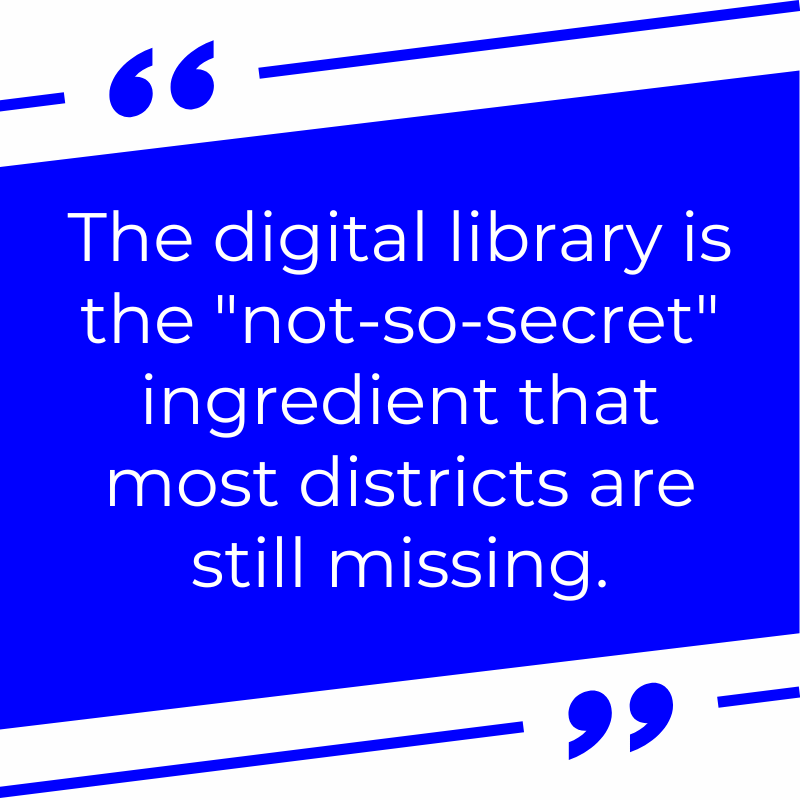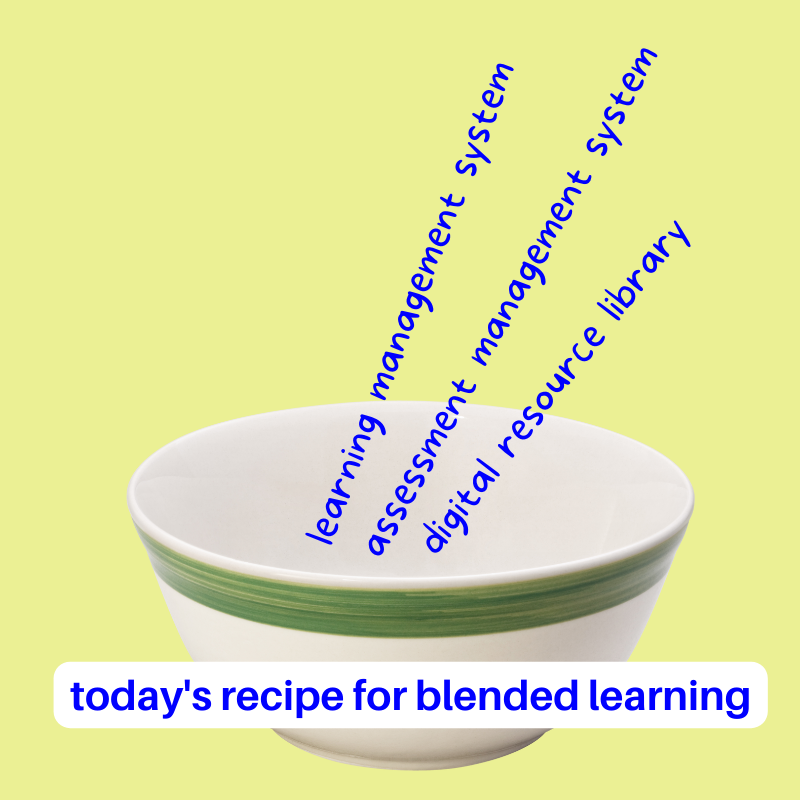The role of the digital resource library from the perspective of an edtech leader and influencer
Marcus Painter is a co-author of Canvas LMS for Dummies1 and creator of the popular Canvascasters2 podcast. He spent 20 years in public education as a teacher and instructional tech leader, before making the leap to the edtech world. Read more about Marcus, below.
I had an epiphany in 2015 when I and a group of fellow Indiana educators were chosen to build one of the most innovative STEM curriculum programs ever, for the Indiana Migrant Education Program. Not only did we create amazing learning opportunities for underserved students, but I had the life-changing realization that I had a strong skill set to teach my peer educators. For the past decade, I’ve had numerous opportunities to speak and coach on various topics in the edtech and digital learning arena―on panels and webinars, at conferences, and in the classroom. My focus has been on “all things edtech,” and that brings me to this fundamental question:
What is the best recipe for blended learning in today’s educational landscape?
In approaching this topic, I like to use the Christensen Institute’s definition3 of blended learning: an approach that “leverages the Internet to afford each student a more personalized learning experience, including increased student control over the time, place, path, and/or pace of learning.” For more reading on the topic, Catlin Tucker, Ed.D.4, professor at Pepperdine University’s Master of Arts in Teaching program, has written extensively on blended learning.
Certainly, the past few years have thrown education into a tailspin full of questions and challenges, but also an abundance of potential learning solutions. In fact, the solutions are so abundant that most of us can find it a bit overwhelming to even choose! What is the best learning management system (LMS)? What assessment platform should we use? How are we providing vetted educational content for educators? How are we supporting STEM/STEAM initiatives, social and emotional learning, and fine arts? The list goes on!
I, along with many others in the edtech world, believe that the pandemic, with all of its horrible consequences, did, in fact, provide education with a much-needed spark toward long overdue changes and recalibration. Frankly, we needed to be nudged out of our comfort zones a bit. So, now what?

Going back in time, the recipe for blended learning before the pandemic was one recipe that seemed to work―at least for those who knew it existed. Ten years ago, my small, rural school district in Indiana adopted this thing called Canvas. At the time, our rationale for the Canvas LMS was largely focused on having the ability to deliver some sort of educational content remotely, especially on inclement weather days. The state of Indiana had permitted what were called “e-learning days,” and in a county with only two snowplows, an LMS made a ton of sense for us as a district. However, our “recipe” wasn’t so much about the best practices for blended learning. At that time, our focus was to have continuity of instruction even during 2 weeks of instructional time canceled due to bad weather. Keeping graduation day on track each year was a key driver, as well.
Our recipes for blended learning during the pandemic felt more like a cookbook you would receive from your great-grandmother. There were no guarantees: try a bit of this, and a sprinkle of that. If this doesn’t work, you did something wrong. Try again! Good luck! The pandemic was educational chaos, and we are now feeling the effects5 of that today. The educational climate feels shaky at best, teacher recruitment and retention are dire issues, and I’m only on page one of the book of challenges K12 educators currently face. However, educators are fighters. We are solution seekers and success makers. But, like any group of professionals, we need the best ingredients to lead learners and ourselves, to success.
Today is a critical point for K12 education. Are we to revert back to the old, pre-pandemic ways? Or can we continue on our current path of technology-enhanced classrooms? What is the ideal recipe for the classrooms of today?
The proliferation of digital tools and apps
I believe that there is a recipe that can work for most K12 educators. And like all recipes, there is room for experimentation! In my years as a technology coach and digital learning coordinator, I became painfully familiar with the sheer volume of digital tools, platforms, websites, and apps that our teachers wanted to utilize with students. I managed many of them in my experiences in K12, and always worked towards streamlining them. Sure, we might be able to save district funds by cutting a subscription for a redundant product or platform, but ultimately, it was about providing consistency and simplicity for educators and students alike.
For many districts, the recipe starts with the LMS. Then we have assessment platforms and strategies for teacher and student accountability, but educational content has remained relatively difficult to grasp. From my vantage point as an edtech professional, I have always felt that learning content was the “Wild Wild West,” where any teacher could use whatever content they chose to best meet the standards for student learning.

Although the proliferation of digital content can feel chaotic, let me be quite clear on this point: in my role as a teacher, I was fully guilty of using all the content that I wanted, rather than utilizing what was suggested or used in the past. I was the guy who taught poetry with Bob Dylan and Stevie Wonder song lyrics, rather than the classic canon. However, at the time I started teaching, I was limited mostly to the textbook and its supplemental materials. Later on, we saw those texts grow, and the supplemental materials exploded into such gigantic collections that you could never actually use all of the materials that the textbook company provided you. I, for one, was overwhelmed!
These days, many districts are even swinging toward the opposite direction and not adopting textbooks at all or are funding a plethora of other types of educational content. While we are at it, let’s go ahead and throw in YouTube, and the proliferation of multimedia educational resources. How can we possibly teach with any consistency with all of that? Also, how can we even manage all of this information from one year to the next? How do we vet the available content? How do we update the content and ensure that it continues to be insightful, engaging, and authentic?
I suggest that the recipe is almost too simple.
The New Recipe = Learning Management System + Assessment Management System + Digital Resource Library
The LMS acts as the hub of all things within a district: it centralizes resources, communications, and learning. Of course, we have learning standards to meet as well, and the assessment management system can be the vehicle for ensuring that teachers and students align teaching and learning with state expectations. But the newest ingredient may be the solution to the chaos districts have experienced for decades. The ability to adopt, implement, and continuously vet and update content within a digital resource library is the “not-so-secret” ingredient that most districts are still missing.
In most districts, teachers share files in OneDrive or Google Drive and try to organize the content themselves, curating and maintaining naming conventions for files and folders―just in time for a teacher to retire, leave the district, or leave education altogether. There is just too much turnover in education for a system like that to scale and survive. So, what if there were a consistent, dependable, searchable way for content to be accessed so that teachers and leaders could easily use, locate, and update it throughout the year?
Like so many edtech innovations over the past decade, I continually find myself saying, “I would have been a much better teacher with _____!” Instructional content was always a struggle for me and is a huge challenge for many educators. Educators need content that is relevant, vetted, engaging, standards-aligned, age-appropriate, unbiased, and easily accessible. And, in addition to all that, we don’t have the time to scour the internet in order to locate those nuggets of ideal content.
That’s where the Learning Explorer solution with its digital resource library comes in as the new ingredient. An intuitive lesson-building and student engagement platform, Learning Explorer enables districts to offer teachers a single hub for digital content. In much the same way that you may sit with your grade level or content area teams in a PLC to dig into assessment data, you can also find, fine-tune, add, and update all types of learning content in Learning Explorer.
A unified hub for digital content
With Learning Explorer you can easily search existing content in the digital resource library, almost like shopping online, but you can also organize and align content to your curriculum maps, pacing guides, or course blueprints. All types of content, from original work you or others have created using Microsoft Office or Google, original videos and tutorials, videos from the internet, images, maps, audio recordings, and more―all can be integrated and accessed in Learning Explorer. To top it all off― and this is the WOW moment for me―Learning Explorer “plays nice” with all the major LMEes, allowing content to be accessed within the LMS platform, rather than opening up separate browser tabs! (We all know the struggle of too many tabs.)
Having a one-stop-shop for instructional content also means that teachers have fewer steps to find appropriate reteaching and remedial resources, following assessments. I’ve always been adamant that the more content we can “bake right in” to our LMS, the better it is for our students. When we think about how our classrooms, schools, and districts will evolve and function efficiently moving forward, it’s clear to me that we need to streamline our technology by fully utilizing these powerful tech ingredients.
LMS + AMS + Learning Explorer = The Blended Learning Recipe, revisited!
…………….
1Painter, M., & Small, E. (2022). Canvas LMS for Dummies (1st ed.). For Dummies. https://www.dummies.com/book/technology/software/other-software/canvas-lms-for-dummies-289707/
2(n.d.). The Canvascasters. Canvascasters. https://anchor.fm/canvascasters
3Christensen Institute (n.d.). Blended Learning. https://www.christenseninstitute.org/blended-learning/
4(n.d.). Blended Learning: What It Is and What It Is Not. Dr. Catlin Tucker. https://catlintucker.com/2021/07/blended-learning-what-it-is-and-is-not/
5Vazquez Toness, B., & Lurye, S. (2023). Thousands of kids are missing from school. Where did they go? The Associated Press. https://apnews.com/article/covid-school-enrollment-missing-kids-homeschool-b6c9017f603c00466b9e9908c5f2183a
…………….
Marcus Painter spent 20 years in public education as a middle and high school English teacher, media specialist, technology coach, testing coordinator, and district administrator overseeing digital learning. In 2021, Marcus took a chance on a new role in edtech. At Instructure, Marcus built and hosted a popular edtech podcast, created a brand, and co-authored “Canvas LMS for Dummies” in his role as a senior manager of Leadership Development and then Customer Advocacy and Engagement. We’re delighted to welcome Marcus as a guest writer. His opinions are his own.


